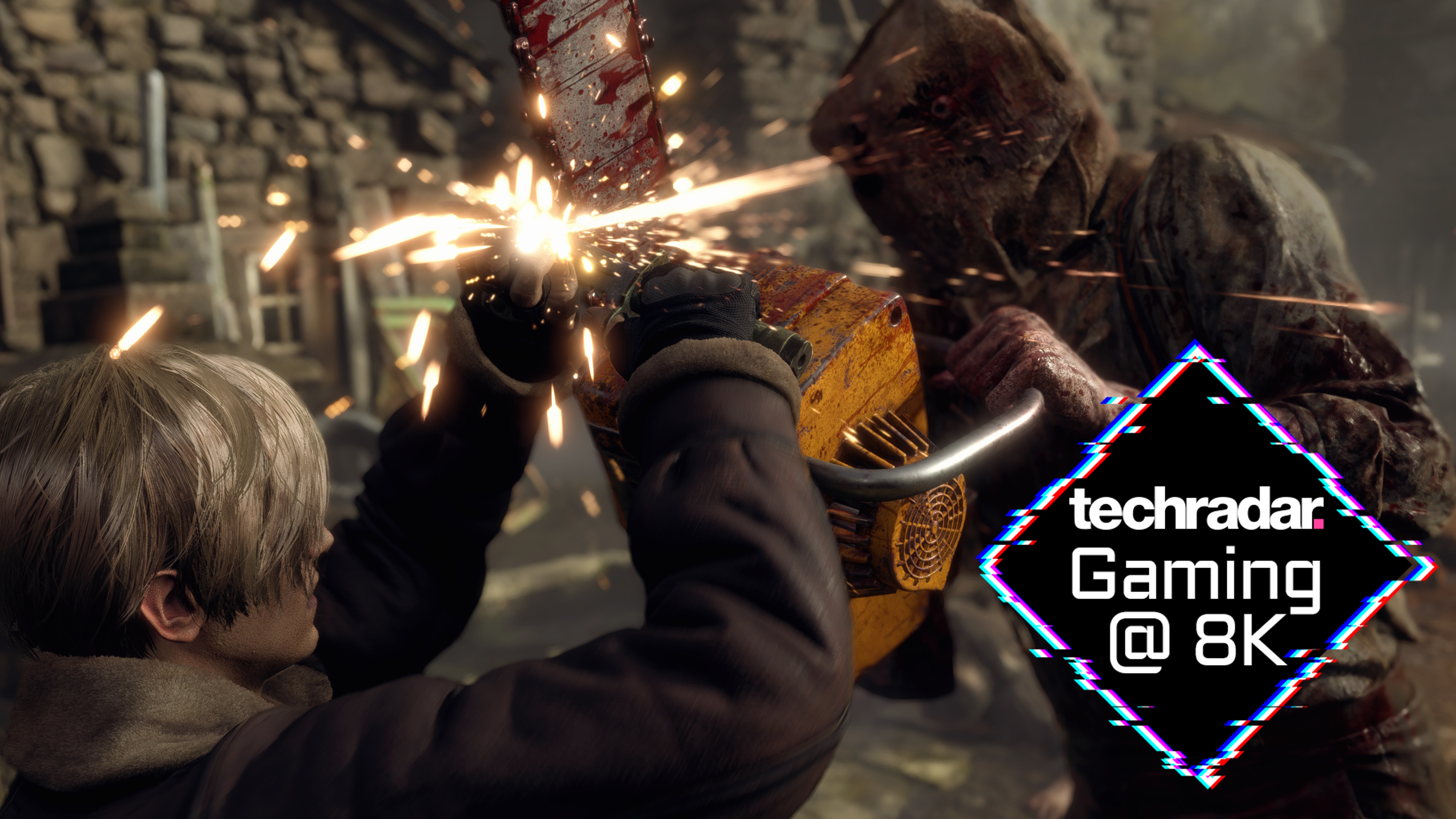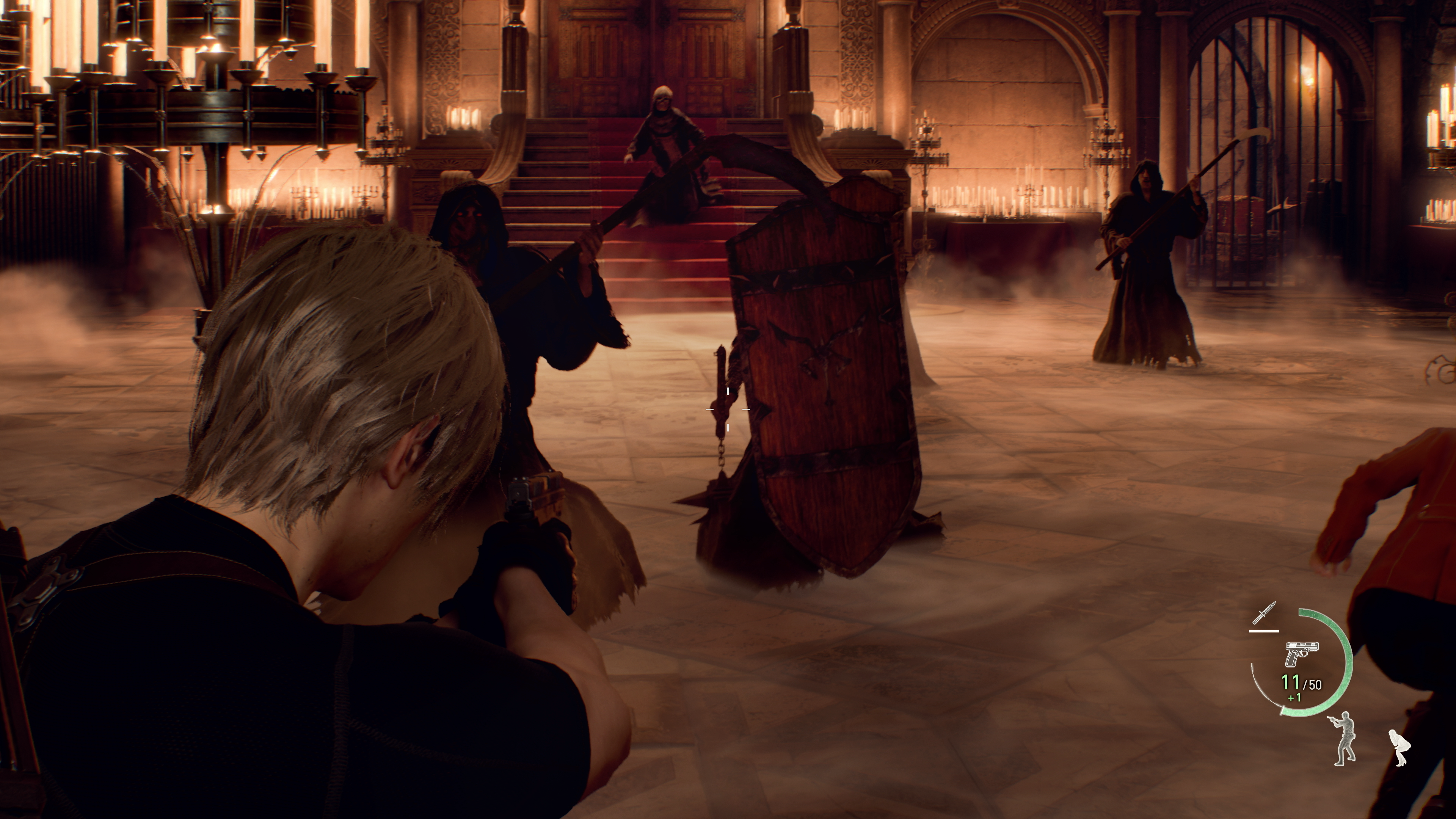Resident Evil 4 is an 8K masterpiece... thanks to AMD
AMD FidelityFX Super Resolution to the rescue

PC built by Stormforce Gaming
Motherboard: Asus PRIME Z-790P LGA 1700
Processor: Intel Core i9-13900K, 24 Cores / 32 Threads
CPU Cooler: Corsair iCUE H100i 240mm ELITE CAPELLIX Liquid CPU Cooler
GPU: Nvidia GeForce RTX 4090
Storage: 1.0TB Seagate FireCuda 530 M.2 NVMe SSD
Case: Corsair iCue 5000X RGB
RAM: Corsair Vengence 32GB DDR5 4800MHz
Screen: LG 55NANO966PA
The original Resident Evil 4 on Gamecube nearly cost me my university degree. Capcom's masterpiece arrived on Nintendo's little square console during my third year at university – and me and my housemate were instantly hooked.
This incredible mix of horror, action, cheesy dialogue, and over-the-top boss encounters sunk its claws into us, and we'd stay up until the early hours playing through the game, swapping the controller between us after every death. Once the game was completed, we'd start again, straight away.
It was amazing fun, but there came a point when I knew I'd have to put the controller down for good and actually do some work. So, when Capcom announced it was remaking the game, I couldn't wait. While I knew it likely couldn't improve on a masterpiece, I was excited to revisit a game I knew so intimately and see how modern technology could transform the experience.
And, as it's now out for various platforms, including PC, I was able to give it a go at 8K resolution as well.
Both familiar and different
On loading the game, the memories came flooding back, and the familiar setting of an undefined rural Spanish forest looked fantastic. While it's not the most graphically impressive game I've ever played, the updated visuals of the remake brought a level of immersion that I haven't felt on my returns to the original game.
Don't get me wrong; when it first launched, Resident Evil 4 was an impressive graphical showcase, giving the Gamecube a rare chance to show off its graphical chops compared to the PlayStation 2, but like many games from that era, time hasn't been too kind.
The PC version of the remake comes with a huge amount of graphical settings to play around with, including ray tracing, so I set the resolution to 8K (7680 × 4320) and whacked the preset on 'Ultra' to see how our Nvidia RTX 4090-equipped gaming PC would cope.
Sign up for breaking news, reviews, opinion, top tech deals, and more.
However, amongst all the options on offer, there was one noticeable absence, and that got me worried about how well the Resident Evil 4 Remake would run at 8K.
Where's the DLSS?
That's right, at the time of writing, there's no option to enable Nvidia's DLSS (Deep Learning Super Sampling) feature. It's a tool that uses the machine learning capabilities of Nvidia's RTX line of graphics cards to intelligently upscale resolutions, allowing for more impressive visuals without the performance cost.
Regular readers of my 8K adventures will know that DLSS has often made the difference between an unplayable slideshow to a 60fps (frames per second) wonder when gaming at 8K.
The lack of DLSS is worrying, but the good news is that Resident Evil 4 Remake does support AMD's alternative: FidelityFX Super Resolution. It does a similar job of upscaling graphics to take the load off the GPU, especially when running at extreme resolutions like 8K, and unlike Nvidia's tech, it's not tied to a set of GPUs, so both AMD and Nvidia hardware can run it - as well as the Xbox Series X, PS5 and Steam Deck.
So, all is not lost. However, I first fired up the game with everything set on maximum, but without FidelityFX Super Resolution turned on.
Playing through the initial town scene, where there are a lot of infected folk (and the odd chainsaw-wielding maniac), our 8K test rig averaged 39.6fps. That's not actually too bad, considering the strain rendering at 7680 × 4320 resolution puts on the GPU, though there were some big drops, hitting just 11.9fps at one point. Those kinds of drops don't make for an enjoyable experience, even if the average frame rate seems high.
When tweaking the graphics settings, you're shown how much video memory you'll need, and at native 8K at the highest settings, Resident Evil 4 Remake requires a huge 17.25GB, putting it out of the reach of all but the most powerful GPUs. The Nvidia RTX 4090 inside our 8K beast has 24GB, so I just got a warning about possible glitches.
AMD has partnered with Capcom for the Resident Evil 4 Remake, possibly explaining the absence of DLSS at launch, so you'd need the AMD Radeon RX7900 XT with 20GB of GDDR6 memory to be able to play at these settings if you wanted to go with Team Red.
Turning FidelityFX Super Resolution 2 on to 'Quality' mode, which tries to preserve image quality as much as possible by upscaling from an already high resolution, the video memory demands dropped to 15.18GB, while average framerate rose to 51.9fps, with a minimum score of 46.6fps.
The game instantly felt a lot smoother (not that Resident Evil 4 was ever really a smooth feeling game, thanks to the Gamecube's tank-like controls), and there was less noticeable stuttering with framerate drops.
I also didn't really notice any difference in image quality between native and with FidelityFX Super Resolution 2 turned on. Sometimes, I've found FidelityFX Super Resolution to add a blurriness around moving objects, but with FidelityFX Super Resolution 2 and the quality setting, I was impressed.
Switching FidelityFX Super Resolution 2 to 'Balanced' knocked the memory use down to 13.23GB - still incredibly high, but could mean slightly more affordable GPUs like the RTX 4080 could at least have a shot at running this game at 8K. The average frame rate again saw a bump up to 56.9fps, with a low of 50.8fps.
Next, I tried FidelityFX Super Resolution 2 at 'Performance', which as the name suggests prioritises performance over graphical quality, and therefore upscales from a lower resolution image. Memory requirements dropped to 12.86GB, and I got on average 59.8fps - pretty much hitting that golden 60fps at 8K goal. However, the frame rate did drop to 52.6fps. I also began to notice some graphical issues creep in, especially with reflections in puddles, which looked a bit strange from a distance, and which weren't evident with the other modes.
Finally, I tried it with FidelityFX Super Resolution 2 set to 'Ultra Performance', and while average frame rate was around the same (59.9fps), the game only dropped to 56.3fps at the lowest, leading to a much smoother experience.
However, the puddle issue remained, and objects in the distance, especially trees and buildings, were noticeably fuzzier.
No DLSS? No problem
Still, these results show that you don't need DLSS to enjoy gaming at 8K - but some sort of advanced form of upscaling certainly helps. AMD's FidelityFX Super Resolution 2 does a fine job as an alternative, and while I found the image quality doesn't quite match DLSS 3 (and it lacks features such as Frame Generation), the fact that AMD has made FidelityFX Super Resolution available to a much wider range of hardware and platforms, and not just its own, is certainly commendable.
If you're getting as excited about 8K gaming as I am, you can order the same high-end setup I used here from Stormforce Gaming in the UK.

Matt is TechRadar's Managing Editor for Core Tech, looking after computing and mobile technology. Having written for a number of publications such as PC Plus, PC Format, T3 and Linux Format, there's no aspect of technology that Matt isn't passionate about, especially computing and PC gaming. He’s personally reviewed and used most of the laptops in our best laptops guide - and since joining TechRadar in 2014, he's reviewed over 250 laptops and computing accessories personally.


